#james webb first full colour image
Explore tagged Tumblr posts
Text



Found: first actively forming galaxy as lightweight as young Milky Way
For the first time, the NASA/ESA/CSA James Webb Space Telescope has detected and ‘weighed’ a galaxy that not only existed around 600 million years after the Big Bang, but also has a mass that is similar to what our Milky Way galaxy’s mass might have been at the same stage of development. Other galaxies Webb has detected at this period in the history of the Universe are significantly more massive. Nicknamed the Firefly Sparkle, this galaxy is gleaming with star clusters — 10 in all — each of which researchers examined in great detail.
“I didn’t think it would be possible to resolve a galaxy that existed so early in the Universe into so many distinct components, let alone find that its mass is similar to our own galaxy’s when it was in the process of forming,” said Lamiya Mowla, co-lead author of the paper and an assistant professor at Wellesley College in Massachusetts. “There is so much going on inside this tiny galaxy, including so many different phases of star formation.”
Webb was able to image the galaxy in sufficient detail for two reasons. One is a benefit of the cosmos: a massive foreground galaxy cluster radically enhanced the distant galaxy’s appearance through a natural effect known as gravitational lensing. And when combined with the telescope’s specialisation in high-resolution imaging of infrared light, Webb delivered unprecedented new data about the galaxy’s contents.
“Without the benefit of this gravitational lens, we would not be able to resolve this galaxy,” said Kartheik Iyer, co-lead author and NASA Hubble Fellow at Columbia University in New York. “We knew to expect it based on current physics, but it’s surprising that we actually saw it.”
Mowla, who spotted the galaxy in Webb’s image, was drawn to its gleaming star clusters, because objects that sparkle typically indicate they are extremely clumpy and complicated. Since the galaxy looks like a ‘sparkle’ or swarm of fireflies on a warm summer night, they named it the Firefly Sparkle galaxy.
Reconstructing the galaxy’s appearance
The research team modelled what the galaxy might have looked like if its image weren’t stretched by gravitational lensing and discovered that it resembled an elongated raindrop. Suspended within it are two star clusters toward the top and eight toward the bottom. “Our reconstruction shows that clumps of actively forming stars are surrounded by diffuse light from other unresolved stars,” said Iyer. “This galaxy is literally in the process of assembling.”
Webb’s data show the Firefly Sparkle galaxy is on the smaller side, falling into the category of a low-mass galaxy. Billions of years will pass before it builds its full heft and a distinct shape. “Most of the other galaxies Webb has shown us aren’t magnified or stretched, and we are not able to see their ‘building blocks’ separately. With Firefly Sparkle, we are witnessing a galaxy being assembled brick by brick,” Mowla said.
Stretched out and shining, ready for close analysis
Since the image of the galaxy is warped into a long arc, the researchers easily picked out 10 distinct star clusters, which are emitting the bulk of the galaxy’s light. They are represented here in shades of pink, purple, and blue. Those colours in Webb’s images and its supporting spectra confirmed that star formation didn’t happen all at once in this galaxy, but was staggered in time.
“This galaxy has a diverse population of star clusters, and it is remarkable that we can see them separately at such an early age of the Universe,” said Chris Willott of the National Research Council Canada, a co-author and the observation programme’s principal investigator. “Each clump of stars is undergoing a different phase of formation or evolution.”
The galaxy’s projected shape shows that its stars haven’t settled into a central bulge or a thin, flattened disc, another piece of evidence that the galaxy is still forming.
‘Glowing’ companions
Researchers can’t predict how this disorganised galaxy will build up and take shape over billions of years, but there are two galaxies that the team confirmed are ‘hanging out’ within a tight perimeter and may influence how it builds mass over billions of years.
Firefly Sparkle is only 6500 light-years away from its first companion, and its second companion is separated by 42 000 light-years. For context, the fully formed Milky Way is about 100 000 light-years across — all three would fit inside it. Not only are its companions very close, the researchers also think that they are orbiting one another.
Each time one galaxy passes another, gas condenses and cools, allowing new stars to form in clumps, adding to the galaxies’ masses. “It has long been predicted that galaxies in the early Universe form through successive interactions and mergers with other tinier galaxies,” said Yoshihisa Asada, a co-author and doctoral student at Kyoto University in Japan. “We might be witnessing this process in action.”
“This is just the first of many such galaxies JWST will discover, as we are only starting to use these cosmic microscopes”, added team member Maruša Bradač of the University of Ljubljana in Slovenia. “Just like microscopes let us see pollen grains from plants, the incredible resolution of Webb and the magnifying power of gravitational lensing let us see the small pieces inside galaxies. Our team is now analysing all early galaxies, and the results are all pointing in the same direction: we have yet to learn much more about how those early galaxies formed.”
The team’s research relied on data from Webb’s CAnadian NIRISS Unbiased Cluster Survey, which include near-infrared images from NIRCam (Near-InfraRed Camera) and spectra from the microshutter array aboard NIRSpec (Near-Infrared Spectrograph). The CANUCS data intentionally covered a field that NASA’s Hubble Space Telescope imaged as part of its Cluster Lensing And Supernova survey with Hubble programme.
This work was published on 12 December 2024 in the journal Nature.
More information
Webb is the largest, most powerful telescope ever launched into space. Under an international collaboration agreement, ESA provided the telescope’s launch service, using the Ariane 5 launch vehicle. Working with partners, ESA was responsible for the development and qualification of Ariane 5 adaptations for the Webb mission and for the procurement of the launch service by Arianespace. ESA also provided the workhorse spectrograph NIRSpec and 50% of the mid-infrared instrument MIRI, which was designed and built by a consortium of nationally funded European Institutes (The MIRI European Consortium) in partnership with JPL and the University of Arizona.
Webb is an international partnership between NASA, ESA and the Canadian Space Agency (CSA).
Image Credit: NASA, ESA, CSA, STScI, C. Willott (NRC-Canada), L. Mowla (Wellesley College), K. Iyer (Columbia)
TOP IMAGE: Thousands of glimmering galaxies are bound together by their own gravity, making up a massive cluster formally classified as MACS J1423.
The largest bright white oval is a supergiant elliptical galaxy that is the dominant member of this galaxy cluster. The galaxy cluster acts like a lens, magnifying and distorting the light from objects that lie well behind it, an effect known as gravitational lensing that has big research benefits. Astronomers can study lensed galaxies in detail, like the Firefly Sparkle galaxy.
This 2023 image is from the James Webb Space Telescope’s NIRCam (Near-InfraRed Camera). Researchers used Webb to survey the same field that the Hubble Space Telescope imaged in 2010. Thanks to its specialisation in high-resolution near-infrared imagery, Webb was able to show researchers many more galaxies in far more detail.
[Image description: Thousands of overlapping objects at various distances are spread across this field, including galaxies in a massive galaxy cluster, and distorted background galaxies behind the galaxy cluster. The background of space is black.]Credit:
NASA, ESA, CSA, STScI, C. Willott (NRC-Canada), L. Mowla (Wellesley College), K. Iyer (Columbia)
CENTRE IMAGE: For the first time, astronomers have identified a still-forming galaxy that weighs about the same as our Milky Way if we could wind back the clock to see our galaxy as it developed. The newly identified galaxy, the Firefly Sparkle, is in the process of assembling and forming stars, and existed about 600 million years after the Big Bang.
The image of the galaxy is stretched and warped by a natural effect known as gravitational lensing, which allowed researchers to glean far more information about its contents. (In some areas of Webb’s image, the galaxy is magnified over 40 times.)
While it took shape, the galaxy gleamed with star clusters in a range of infrared colours, which are scientifically meaningful. They indicate that the stars formed at different periods, not all at once.
Since the galaxy image is stretched into a long line in Webb’s observations, researchers were able to identify 10 distinct star clusters and study them individually, along with the cocoon of diffuse light from the additional, unresolved stars surrounding them. That’s not always possible for distant galaxies that aren’t lensed. Instead, in many cases researchers can only draw conclusions that apply to an entire galaxy. “Most of the other galaxies Webb has shown us aren’t magnified or stretched and we are not able to see the ‘building blocks’ separately. With Firefly Sparkle, we are witnessing a galaxy being assembled brick by brick,” explains astronomer Lamiya Mowla.
There are two companion galaxies ‘hovering’ close by, which may ultimately affect how this galaxy forms and builds mass over billions of years. Firefly Sparkle is only about 6500 light-years away from its first companion, and 42 000 light-years from its second companion. Let’s compare these figures to objects that are closer to home: the Sun is about 26 000 light-years from the centre of our Milky Way galaxy, and the Milky Way is about 100 000 light-years across. Not only are Firefly Sparkle’s companions very close, the researchers also suspect that they are orbiting one another.
[Image description: Horizontal split down the middle. At left, thousands of overlapping objects at various distances are spread across this galaxy cluster. A box at bottom right is enlarged on the right half. A central oval identifies the Firefly Sparkle galaxy, a line with 10 dots in various colours.]Credit:
NASA, ESA, CSA, STScI, C. Willott (NRC-Canada), L. Mowla (Wellesley College), K. Iyer (Columbia)
LOWER IMAGE: Thousands of glimmering galaxies are bound together by their own gravity, making up a massive cluster formally classified as MACS J1423.
The largest bright white oval is a supergiant elliptical galaxy that is the dominant member of this galaxy cluster. The galaxy cluster acts like a lens, magnifying and distorting the light from objects that lie well behind it, an effect known as gravitational lensing that has big research benefits. Astronomers can study lensed galaxies in detail, like the Firefly Sparkle galaxy.
This 2023 image is from the James Webb Space Telescope’s NIRCam (Near-Infrared Camera). Researchers used Webb to survey the same field the Hubble Space Telescope imaged in 2010. Thanks to its specialisation in high-resolution near-infrared imagery, Webb was able to show researchers many more galaxies in far more detail.
The north and east compass arrows show the orientation of the image on the sky.
The scale bar is labelled in arcseconds, which is a measure of angular distance on the sky. One arcsecond is equal to an angular measurement of 1/3600 of one degree. There are 60 arcminutes in a degree and 60 arcseconds in an arcminute. (The full Moon has an angular diameter of about 30 arcminutes.) The actual size of an object that covers one arcsecond on the sky depends on its distance from the telescope.
This image shows invisible near-infrared wavelengths of light that have been translated into visible-light colours. The colour key shows which NIRCam filters were used when collecting the light. The colour of each filter name is the visible light colour used to represent the infrared light that passes through that filter.
NIRCam filters from left to right: F115W and F150W are blue; F200W and F277W are green; F356W and F444W are red.
[Image description: A graphic labelled “James Webb Space Telescope; MACS J1423.8+2404.” A rectangular image shows thousands of galaxies of various shapes and colours on the black background of space.]Credit:
NASA, ESA, CSA, STScI, C. Willott (NRC-Canada), L. Mowla (Wellesley College), K. Iyer (Columbia)
youtube
9 notes
·
View notes
Text
The Hubble Deep Field
Post #14 in Physics and Astronomy, 12/12/2023
A while ago, I was just scrolling for interesting parts of space and stumbled across the Pillars of Creation and the Hubble Deep Field. I was intrigued by both, mainly because of the intricate and breathtaking nature of the respective images, so you can find my post about the Pillars of Creation here; in this post, I'm going to be giving you pretty pictures and explaining the context behind it.
The Hubble Deep Field from 2004 is the deepest portrait we have yet of the observable Universe. It reveals some of the first galaxies to emerge from the ‘Dark Ages’; this is the time shortly after the Big Bang when the first stars began to heat our Universe.

The Hubble Telescope reached the limit of what’s possible to see in visible light. This is because light shifts so far along the spectrum for very distant objects that they’re gone from the spectrum altogether; this means we just can’t see it with telescopes.
One interesting way to interpret telescopes is to think of them as time machines. Yes, you read that correctly, time machines. Think about it: the speed of light is not infinite, so it takes an increasingly noticeable length of time to travel very large distances. This is where the definition of light-year comes from–the distance light travels when it has been travelling for a year. Since the way we see things is through light hitting our retina, when we look at objects in space far, far, away, we’re seeing the image of it in the past.
For ten days during Christmas season in 1995, the Hubble Space Telescope looked out thoughtfully over a large section of the sky. It gathered what light it could, building an image over time. What emerged next, the Hubble Deep Field, revealed many galaxies. You may be surprised to find out that the light from some of these galaxies took 10,000,000,000 years to reach us.
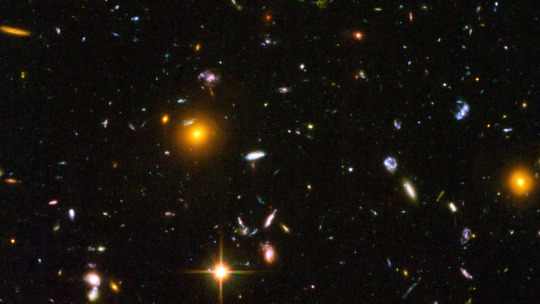
The full image shows over 3,000 galaxies of various shapes and sizes, and through the Deep Field, we’re plunging ourselves arm-deep back into time, where galaxies emerged from the Big Bang’s chaos.
In 2004 (which isn’t even that long ago!) we got images of the Hubble Ultra Deep Field—a precious image constituted from the work of numerous astronomers, revealing one of the deepest and most colourful depictions of our changing Universe.

The Ultra Deep Field contains around 10,000 galaxies, going as far back in time to get within a few hundred million years of the Big Bang.
The Hubble Telescope provided an ultraviolet-light dataset, that, when combined with infrared data from the James Webb Telescope, helped create such a beautiful image.
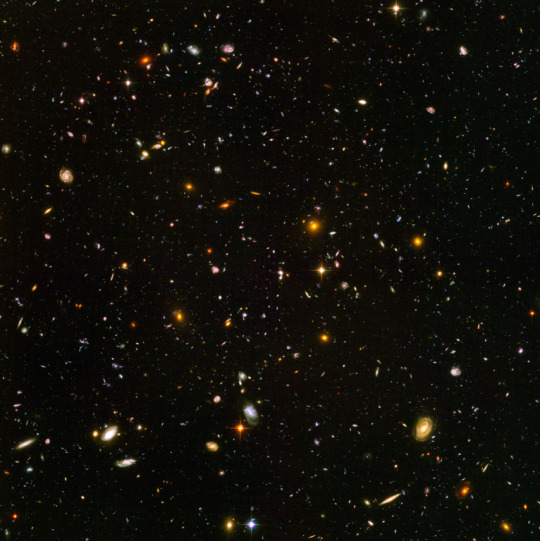
All images taken from Hubblesite and NASA!
#studyblr#stem#physics#astronomy#astrophysics#hubble telescope#hubble#hubble space telescope#james webb telescope#james webb#deep field#the hubble deep field#hubble deep field#astrophotography#astro posts
43 notes
·
View notes
Text
Gallery visit: Museum of American Art (3.7.24)
Nam June Paik's television works
Rows 1 and 2: Electronic Superhighway: Continental U.S., Alaska,Hawaii (1995, installation - 51-channel video installation (including closed-circuit television feed; colour, sound), custom electronics, neon lighting, steel, and wood)
Row 3: Zen for TV (1963/1976, manipulated television set)
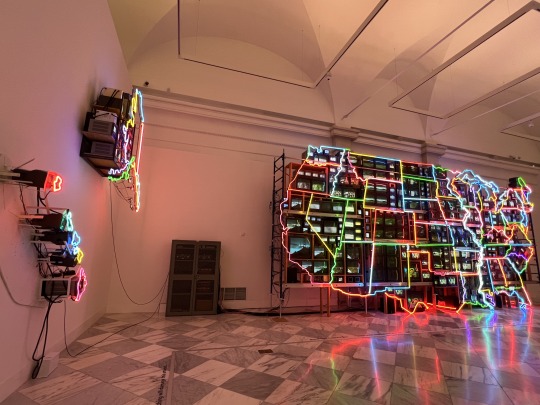
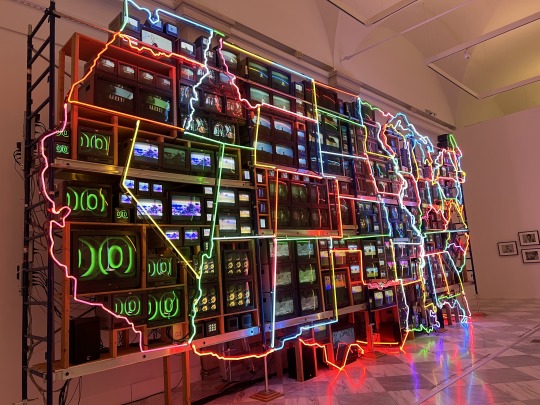

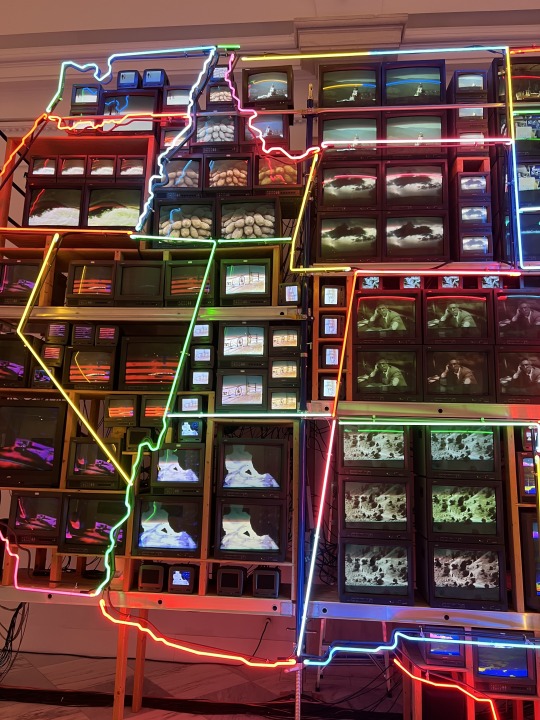
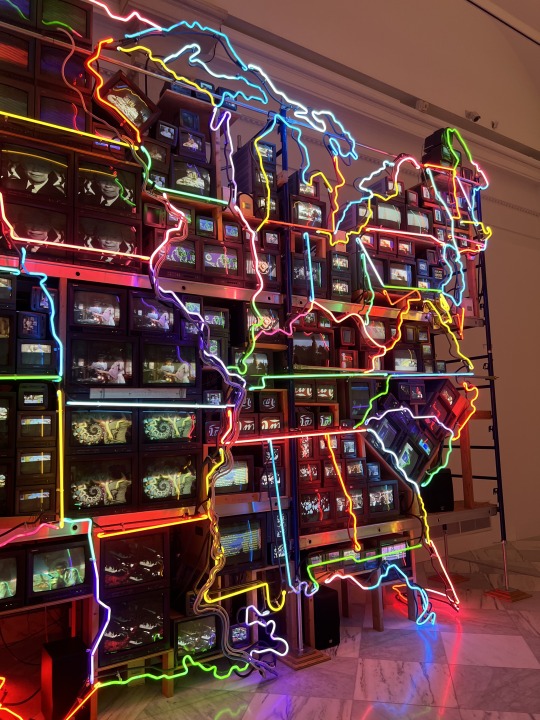
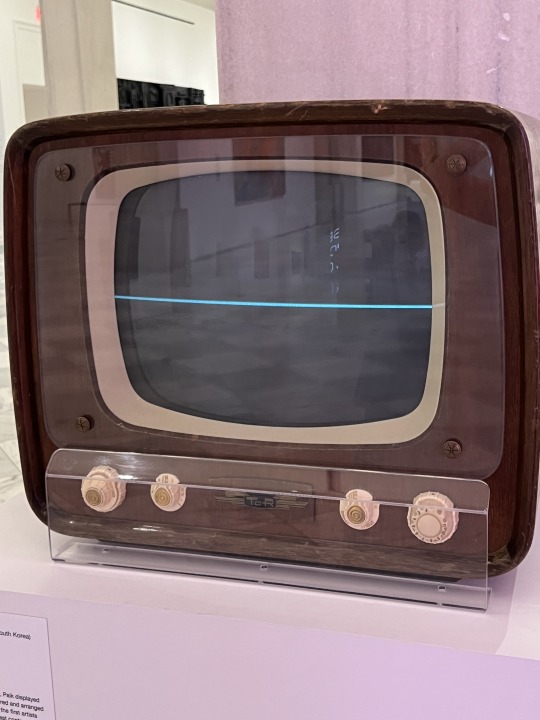
Description for Electronic Superhighway: Continental U.S., Alaska, Hawaii (1995): "Paik predicted, in 1965, that "someday artists will work with capacitors, resistors, and semiconductors as they work today with brushes, violins and junk." Over the decades, his own work stayed in constant conversation with how new technologies reshape the world. Electronic Superhighway playfully engages three such forces: the US interstate highway system, cable television, and the emergent internet of the 1990s. In this TV map, neon-outlined states play a mix of borrowed and original footage. Each distinct channel reveals Paik's associations with or understanding of that state. Some video collages draw from personal connections, like Paik's recordings of longtime collaborator and cellist Charlotte Moorman filling the screens in her home state of Arkansas (along with images of then president Bill Clinton, also from Arkansas). Others incorporate existing media representations, with the movie musical Oklahoma! filling Oklahoma, and edits from a documentary on the 1950s Montgomery bus boycotts echoing from Alabama. A closed-circuit camera marks Washington, DC, where gallery visitors can see themselves in real time. This suggests the map is also a portrait, reflecting how media and mediation shape views of ourselves and each other at national, regional, and individual levels."
Description for Zen for TV (1963/1976): "In a 1963 exhibition in Germany, Paik displayed a room full of electronically altered and arranged televisions, making him one of the first artists to use actual TVs and broadcast content to make art. One set arrived broken, compressing all received signals into a thin line of light. Paik embraced its broken state and titled it Zen for TV, playfully and profoundly linking its accidental minimalism to the meditative focus of Zen Buddhism, a religious reference he often used to signify an Asian perspective in Euro-American contexts. Zen for TV became one of Paik's signature works, and over the years he created select versions like this one."
Firelei Báez's Untitled (Premiere Carte Pour 'Introduction à L'Histoire du Monde) (2022, oil and acrylic paint on archival printed canvas)
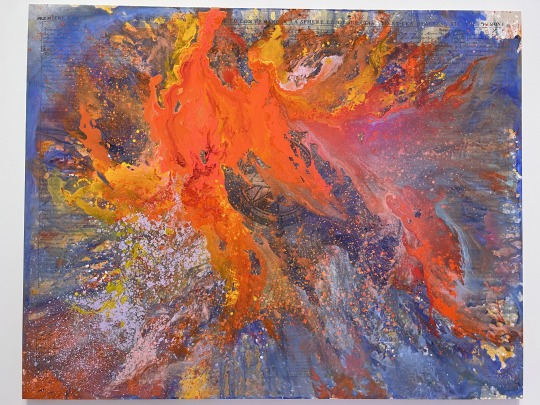
Description: "What do you see in Firelei Báez's plumes of orange, red, and blue? Her painting might evoke the eye of a hurricane, an exploding supernova, or consuming flames. Beneath the swirling streams of paint lies an image of the Atlas Historique, a map created in 1718 to document the recently conquered European colonies. Charting the farthest reaches of human knowledge at that time, the Atlas joined the earth, the solar system, and the constellations into one view. Originally from the Dominican Republic, Báez thinks about the ways her own life has been shaped by the legacies of colonialism. She sees her art as a conversation with this earlier period, opening up space for questions and alternative histories. Here, she might be imagining the world represented by the Atlas ending in dramatic fires and floods. Or she could be continuing its traditions: her own imagery was inspired by the fantastical pictures of outer space transmitted by the James Webb Space Telescope in 2021 - today's equivalent of the eighteenth-century star map."
Thornton Dial Sr.'s The Beginning of Life in the Yellow Jungle (2003, plastic bottles, doll, clothing, bedding, wire, found metal, rubber glove, turtle shell, artificial flowers, Splash Zone compound, enamel, and spray paint on canvas mounted on wood)
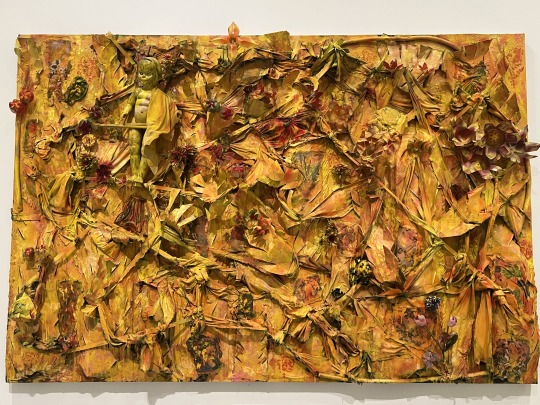

Description: ""When I start making something, I gather up the pieces I want to work with." Thornton Dial once explained. "Everything I pick up be something that done did somebody some good in their lifetime.. When you make things beautiful out of another person's ideas, it make the world more beautiful." Dial mastered the art of speaking through objects-he gathered, combined, and painted them to create artworks that ask us to look closely and think carefully. Here, he invokes a jungle landscape, a place where survival can be hard. In Dial's 'jungle scape', wild and urban realms are indistinguishable: plastic cups and bottles are plants, rubber gloves and rags are vines. The entire scene is conjured from something found, repurposed, and reimagined. Across nine decades in Alabama, Dial experienced racism and oppression firsthand, but he discovered that he could speak freely through artmaking. Dial's critiques of race relations were often somber, dark in color and mood. Yet here, warm hues shower the day in optimism; polarised divisions of black and white give way to a sunny palette of possibility."
Louise Nevelson's Sky Cathedral (1982, painted wood)
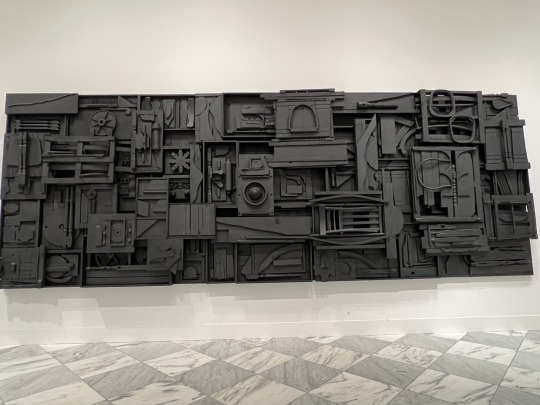
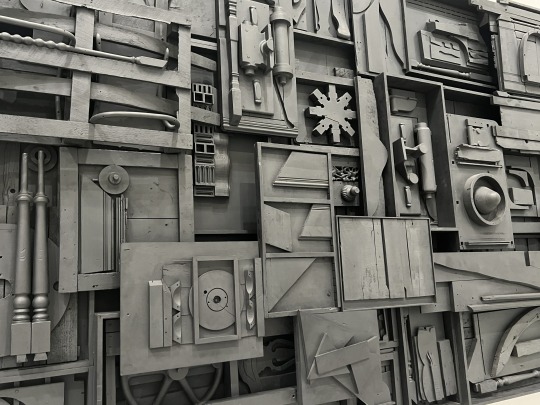
Description: "Can you identify any of the everyday objects in the black field of Sky Cathedral? Louise Nevelson was an avid collector of objects, and she assembled various found wooden scraps - table legs, bannisters, rolling pins, milk crates, mouldings, and other architectural fragments-to create her sculptures. Although it's possible to see the shapes and outlines of these elements, they are absorbed into the large, uniformly painted black wall. Nevelson aimed to create a spiritual experience out of everyday objects, transforming them from the material to the immaterial. Sky Cathedral evokes what Nevelson called "the heavenly spheres, the places between the land and the sea" that lie beyond our experience of ordinary things."
Alfred Jensen's Honor Pythagoras, Per I-Per VI (1964, oil paint on canvas)
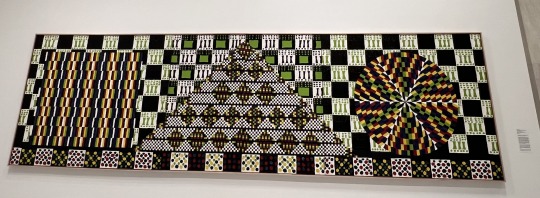



Description: "Alfred Jensen strove to reveal the connections between art, science, and spirituality. For him, the thousands of strokes of colour that he applied across these six conjoined canvases expressed the unity of all things. The coloured triangles represent prisms that break white light into brilliant hues, and the geometries and numbers underlie the basic order of the universe. Jensen was inspired by mathematics, but also by visual forms from around the world, including calendars and counting systems from Arabic, Mayan, and Chinese cultures. The painting - one of the artist's largest - contains complex symbols and ideas, yet it operates very simply on another level: undiluted colour, shape, and rhythm combine to create a harmony that appeals to the eye and the body as much as to the mind."
Kenneth Victor Young's Untitled (1973, acrylic paint on canvas)
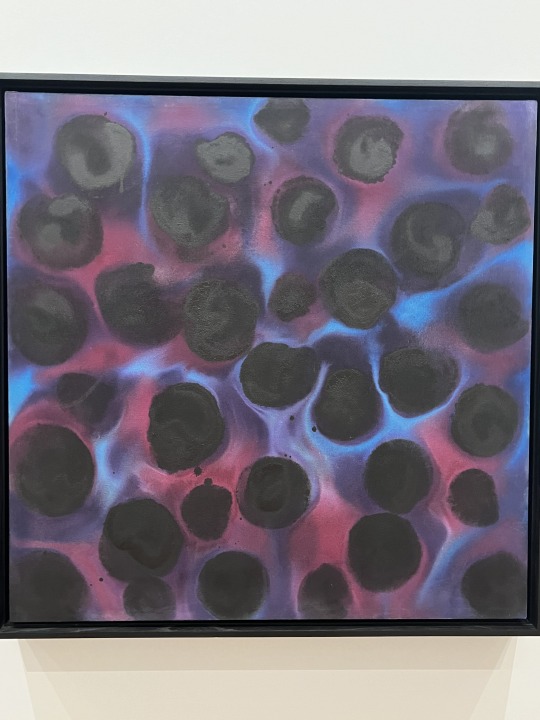
Description: ""I've always been interested in … outer space, inner space, and the development of what occurs - force, magnetism, and that kind of thing." - Kenneth Victor Young In Untitled, Kenneth Victor Young cultivates an uncertain sense of space and scale. Black orbs float in a dark field, potentially representing either a microscopic or celestial view. The colorful halos around the orbs were created by applying paint "wet into wet" and allowing it to freely blend and move. Like Sam Gilliam, whose unstretched painting Swing hangs nearby, Young grew up in Kentucky and studied painting at the University of Louisville before moving to Washington, DC, in the 1960s. Only after settling in DC, did either artist begin working in a fully abstract mode."
Simon Gouverneur's Mara (1989, egg tempera, acrylic paint and coloured pencil on canvas)
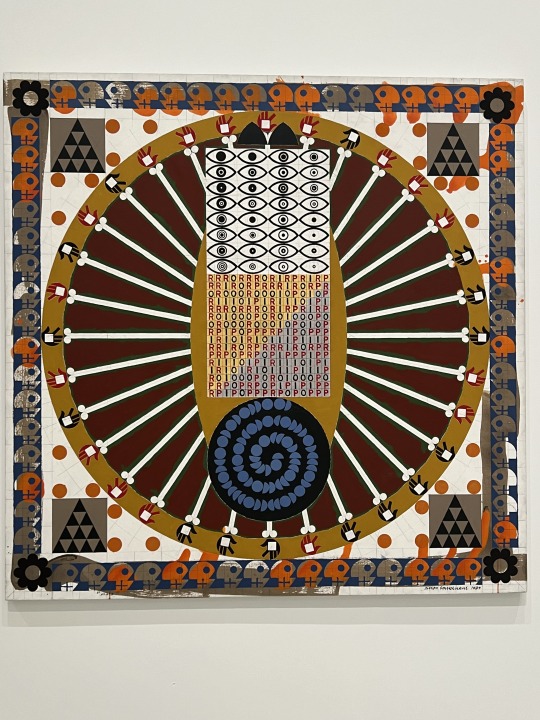
Description: "With its rings of colorful shapes and patterns, abstracted eyes, hands, pyramids, and letters, Mara appears to be at once puzzle and code. Simon Gouverneur constructed his compositions from a visual vocabulary of images and symbols derived from various religions, including Buddhism, Hinduism, Jewish mysticism, and ancient American traditions. Influenced in part by the painter Alfred Jensen-whose work is on view nearby-he sought to reveal a universal language that joined spiritual practices across cultures. Gouverneur worked very slowly: he mixed his own pigments, rather than relying on commercially available paints, and applied his paint with many tiny, meditative strokes. His methodical process connected him to generations of artists but existed in tension with the expansive and mystical experiences he aimed to create."
Gretchen Bender's TV Text & Image (DREAM NATION) (1989, live television broadcast on a monitor with vinyl lettering)

Description: "How does today's news relate -or not-to your idea of a "dream nation"? Unlike most screens in an art gallery, this monitor is not showing prerecorded, artist-made imagery. Instead, the artist intervenes in regular broadcast television by printing DREAM NATION on the surface of the screen. Gretchen Bender's work invites you to contrast your current take on these words with what is on TV at this very moment. When displayed in the nation's capital of Washington, DC, it can also feel site-specific, invoking this country's dreams and dreamers. Bender was part of a generation of artists, including Barbara Kruger (whose work is on view nearby), who responded to the rising power of mass media. Using what she described as "guerrilla tactics . . . to make some kind of break or glitch in the media," Bender took on television to make the "underlying patterns of social control" visible."
Kapulani Landgraf's Puka mai (2002, handwoven silver gelatin collage)
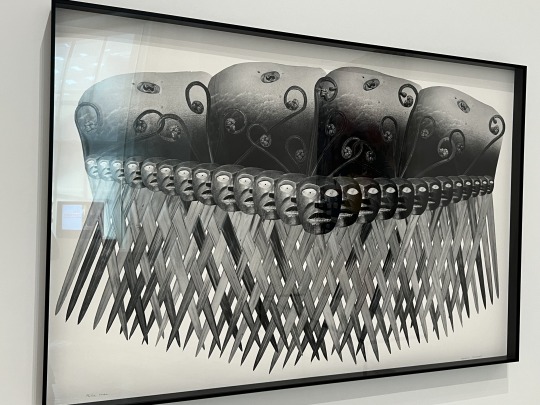
Description: "Made from hand-cut and dry-mounted photographs, Puka mai calls for Kanaka 'Öiwi (Native Hawaiians) to hold on to their connection to their birthplace and thus their ancestors. The images that make up the collage reference important metaphors to the indigenous people of Hawaii. At bottom, the long, pointed bills of marlin fish - traditionally used by Hawaiians as daggers - are woven together to suggest the aboveground roots of the hala tree, symbolically securing Hawaiians to their homeland. Above the bills runs a line of 'aumākua (family gods) sculptures topped by images of hö'i'o (young fern shoots). The unfurling shoots represent future generations of Hawaiians."
Isaac Julien's Lessons of the Hour (2019, short film installation - 28 mins 44 secs)

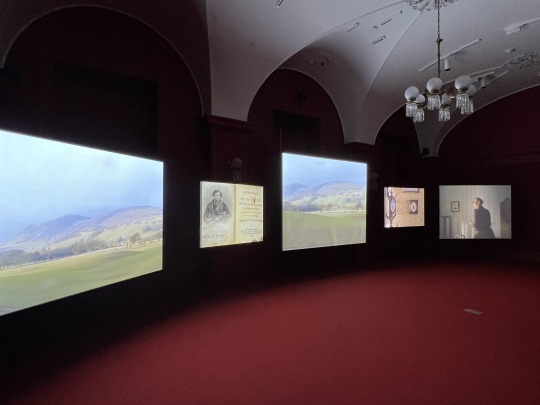
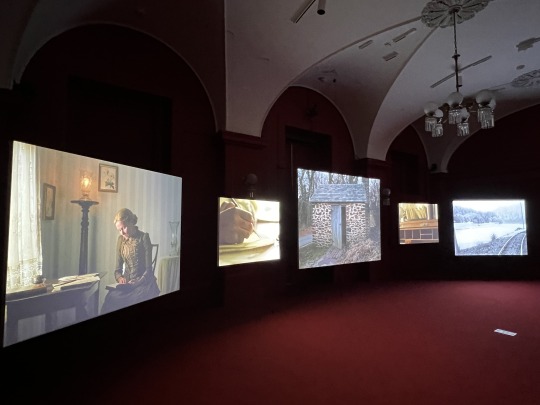
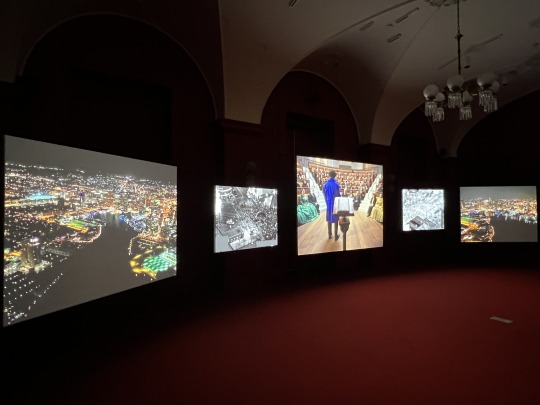


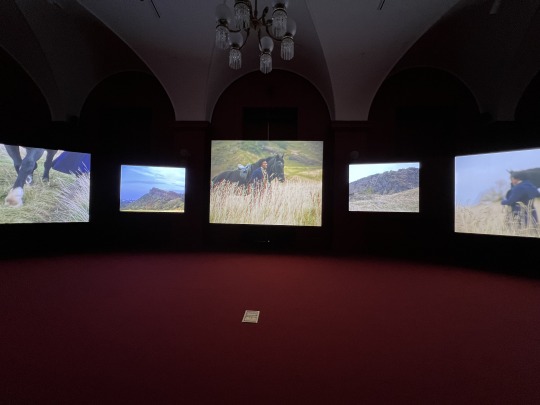
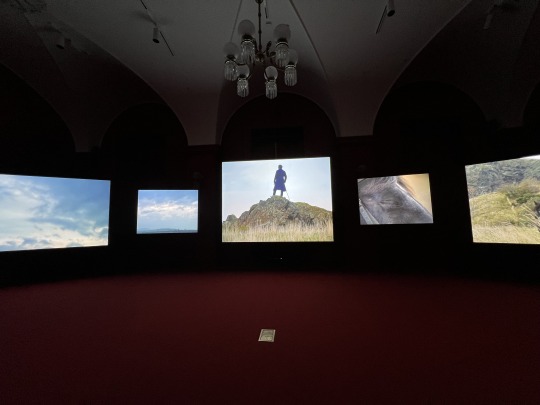
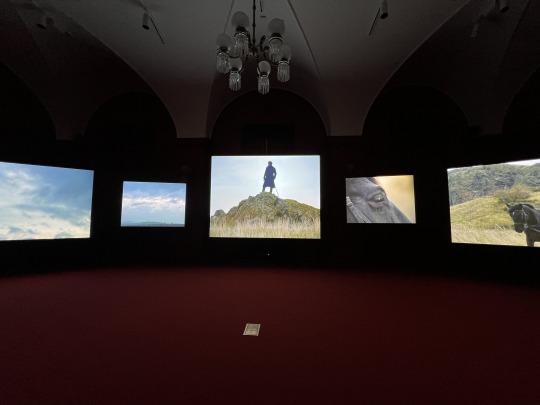

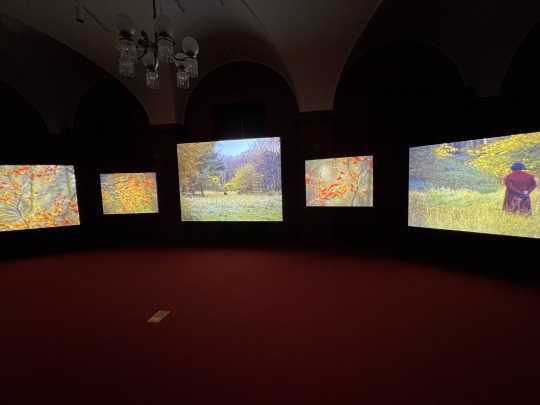
Description: "Sir Isaac Julien's Lessons of the Hour immerses us in the towering legacy of abolitionist, writer, and philosopher Frederick Douglass (1818-1895). Julien, an innovator of moving-image installations, interweaves period reenactments across five screens to share a vivid picture of Douglass's world. Douglass gave thousands of antislavery lectures, several of which focused on photography's power in "reaching and swaying the heart by the eye." Julien draws dialogue for Lessons of the Hour from three of Douglass's speeches. Additionally, the artist meticulously restages the studio of African American photographer J. P. Ball (1825-1904). There, Douglass, the most photographed American of the nineteenth century, sits for his portrait. Julien also filmed Douglass's historic home in Washington, D.C., with actors playing Douglass's first wife, activist Anna Murray Douglass (c. 1813-1882), and his second, Helen Pitts Douglass (1838-1903). Julien includes them and the abolitionist's wider circle to emphasise how collective action produces radical change. Footage of contemporary Baltimore, the city where Douglass escaped enslavement in 1838, interrupts these reenactments. We witness fireworks erupting over Baltimore harbor and FBI aerial surveillance of protests over Freddie Gray Jr.'s 2015 death in police custody. During this sequence, Douglass, played by Royal Shakespearean actor Ray Fearon, recites his speech "What to the Slave is the Fourth of July?" Entangling past and present, Lessons of the Hour poses Douglass's prophetic question to us. Lessons of the Hour represents the first joint acquisition between the National Portrait Gallery and the Smithsonian American Art Museum. As Julien brings Douglass's work to bear on "this very hour," we hope this installation, displayed at the center of our nineteenth-century building, will inform your experience of both museums' historic collections. Through deep research, creative speculation, and a marriage of poetic image and sound, Julien foregrounds Douglass's enduring lessons on abolition, justice, and freedom."
1 note
·
View note
Text
Week 2 SDL
A Brief History of Photography Part 2
In 1888 the first Kodak film camera was released, so now the process of 'printing' photos was no longer the responsibility of the photographer - this made the skill more accessible to everyone. Even children, in the 1920s two cousins created the infamous fairy photos.

It was only released 60 years later that the photos were in fact: fake.
From this point in the essay, it states that the thought of social media is 'manipulated' since the poster only uploads what they want others to see and is never entirely 'truthful' in what they share.
This also sparked the conversation as to whether black and white photographs were 'truthful' seeing as the use of colour would then be presenting something in their intended way. (To combat this, colouring photographs became an entire service for people) But then this sparked another debate about whether this took AWAY from the truth of an image?!
In my opinion, I believe that the use of black and white photographs is perfectly appropriate because before coloured photography was even a thing, black and white was the only option - this does not make these photographs any less valid because the technology had not yet progressed. I do think that colouring an image that was originally black and white is 'manipulation' because the painter could use any colour and it could never be entirely truthful anyway. This technique is still used today, but instead of painters, AI is now doing this job and calling it 'Colourized History'.
Staging Truth
This section in this essay was very interesting to me because it mentioned a few photographs that I have encountered previously. Such as 'Lunch Atop A Skyscraper' and 'Migrant Mother'. These were controversial for different reasons.

"Lunch Atop a Skyscraper" was controversial in the fact that the men in the photograph were all staged by the photographer. I researched further into this a little by watching this YouTube video which was very enlightening.
youtube
This video discusses how although the photograph was staged, it still served the purpose it was created for:

In my personal experience, staging a 'candid' photograph can be a really nice way to document something. I was asked to do a maternity photoshoot for a family friend but she didn't want her photos taken in a studio, but on the beach, so of course the entire photoshoot would then become 'staged'. I feel if someone chooses to document something this way, it doesn't make the scenario any less 'truthful'.

And then "Migrant Mother" became controversial because the photographer edited out a thumb from the bottom right of the photograph (and bumped up the contrast with a filter). However, I believe the removal of the thumb (which was the topic under question) wasn't that big of a deal - if anything, the addition of it is a creepy unnecessary aspect of the photograph and to remove it via cropping would have changed the image too much.

I liked John Berger's quote: "every image embodies a way of seeing" as we don't see anything above, under or around the image is showing. There is always different ways to interpret a photograph because of this.
And to conclude the essay, the mention of Adobe's Photoshop being released in 1990.
Yes, NASA Did Manipulate The Webb Telescope’s First Color Images Last Week—But Don’t Call Them ‘Fake’

The James Webb Space Telescope's first full-colour images show a very colourful scene of space. However, the images were heavily edited to highlight all of the colours and details.

Before the images can even be edited, they need to travel and be sent through many different channels to even just get back to earth. The photos don't show the actual colours it sees since it detects infrared light. They use filters to turn this into visible colours.

Making the images is super complicated and takes a few weeks to turn raw data into colourful pictures. Even the first images, made from just a few days of observations, show we're only scratching the surface of what's actually out there.
Overall, I found this article quite interesting because I hadn't realised that 'space cameras' are using an entirely different way of photographing than I am used to, and to turn those images into 'real' depictions takes a lot of time and effort.
Ultraviolet Photography
Ultraviolet photography captures images using UV light, which is invisible to human eyes. It's used in science, medicine, and art to reveal details not seen in regular light like bruises and scars in forensic work to detect sun damage in dermatology and to capture unique perspectives of nature.


We see the 'visual' spectrum but there are still more kinds of light on either side of this (such as ultraviolet and infrared - to be looked into after this).
I did some further research on this topic to see some examples of this in action:
youtube
Learn How To Take Infrared Photography
Infrared photography started for government surveillance but now is used creatively. Although infrared film is rare and expensive, you can recreate the look with Adobe Photoshop. Infrared photography transforms landscapes with strange, otherworldly colours by capturing light invisible to the human eye, making it great for seeing through haze and fog.
Although useful, I found this article a little hard to understand what infrared light actually is so I did some more research into the matter.
youtube
Once I got some clarity I was AMAZED that I was someone with the common misconception that infrared photography was heat vision! I think this belief was what was confusing me previously when I read the supplied article. (Even if this kind of photography is still technically under the infrared umbrella).


The video also explained the spectrum of light either invisible or visible to the human eye.

This also clarified the colour changes that happen in infrared photography. The colours closer to the infrared side of the spectrum would become brighter, and the colours further away would become darker.

... and with that, my week 2 SDL is now concluded <3
0 notes
Photo

About the Object Distance:390 light years Constellation:Ophiuchus Coordinates Position (RA):16 26 30.56 Position (Dec):-24° 23' 7.40" Field of view:6.65 x 6.23 arcminutes Orientation:North is 80.6° left of vertical The first anniversary image from the NASA/ESA/CSA James Webb Space Telescope displays star birth like it’s never been seen before, full of detailed, impressionistic texture. The subject is the Rho Ophiuchi cloud complex, the closest star-forming region to Earth. It is a relatively small, quiet stellar nursery, but you’d never know it from Webb’s chaotic close-up. Jets bursting from young stars crisscross the image, impacting the surrounding interstellar gas and lighting up molecular hydrogen, shown in red. Some stars display the telltale shadow of a circumstellar disc, the makings of future planetary systems.
The young stars at the centre of many of these discs are similar in mass to the Sun or smaller. The heftiest in this image is the star S1, which appears amid a glowing cave it is carving out with its stellar winds in the lower half of the image. The lighter-coloured gas surrounding S1 consists of polycyclic aromatic hydrocarbons, a family of carbon-based molecules that are among the most common compounds found in space.
0 notes
Text

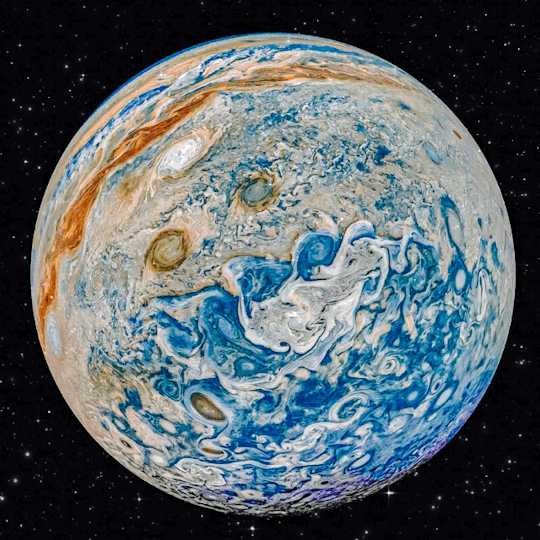
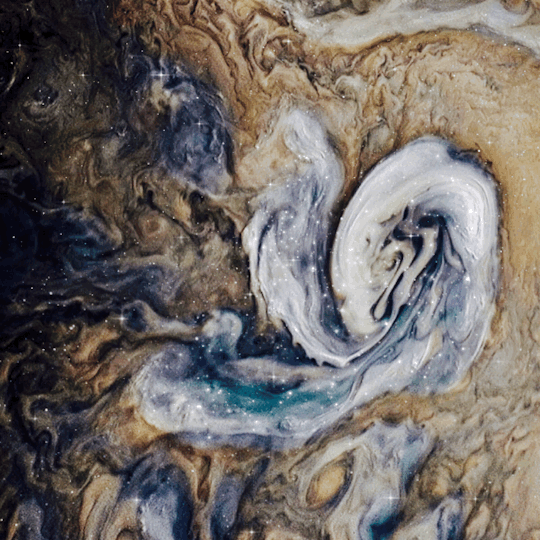
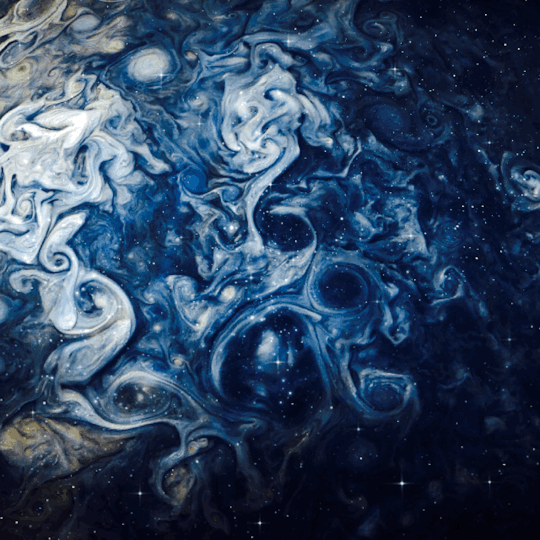
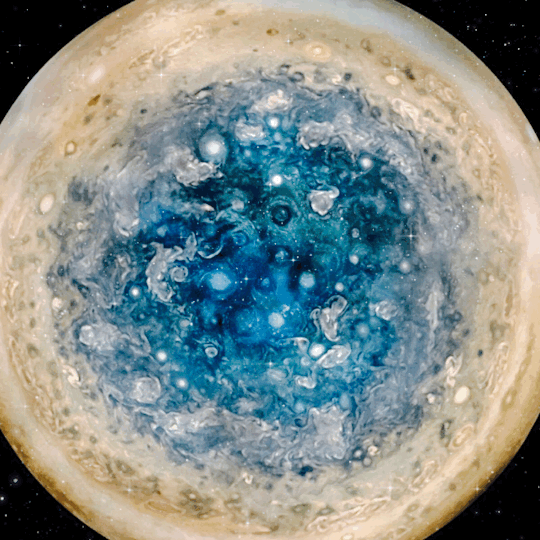
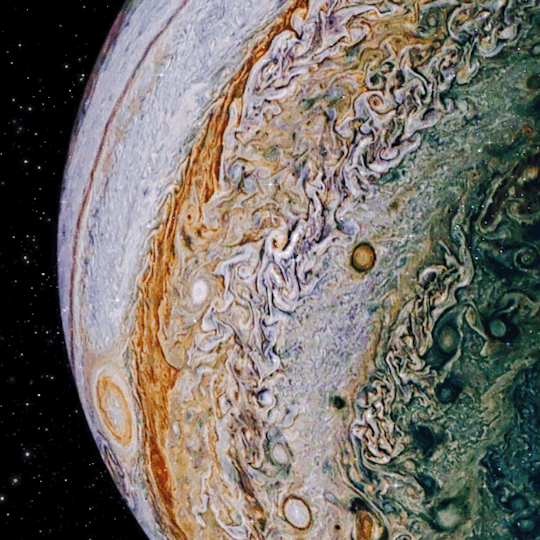
✨The Beauty of Jupiter ✨
#gifs (edits) made by me :)#assassin1513#space#space vibes#space aesthetic#jupiter#planet#planets#james webb#james webb first full colour image#james webb space telescope#james webb update#james webb deepest sharpest view of universe#webb#james webb telescope#james webb images#solar system#astrology#astronomy#nasa#beyond the stars#stars#infinity#jupiter planet#glitter#outer space#void#space art#magic#vincent van gogh
52K notes
·
View notes
Text
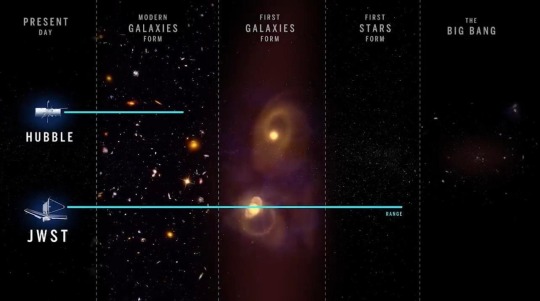
Hubble and James Webb comparison.
Hubble space telescope can see back to 13.5 billion years, around when the modern galaxies were formed and the Big Bang happened 13.8 billion years ago. With the JAMES WEBB telescope we can peer into an unseen time period in the universe- back to when the first galaxies, the first black holes and the first stars came into existence.
James Webb telescope is as close as we ever got to understand the Big Bang!!!!!
This is Amazing.
#nasa#astronomy#galaxy#space#james webb telescope#james webb images#james webb space telescope#james webb update#universe#science#astrophotography#cosmos#jwst#physics#planets#stars#black hole#james webb first full colour image#james webb deepest sharpest view of universe#james webb 5 points on what new telescope aims to achieve james webb#webb telescope#nebula#amazing#scientific#tags dont work#telescope#astrophysics#space science#hubble#hubble telescope
683 notes
·
View notes
Text
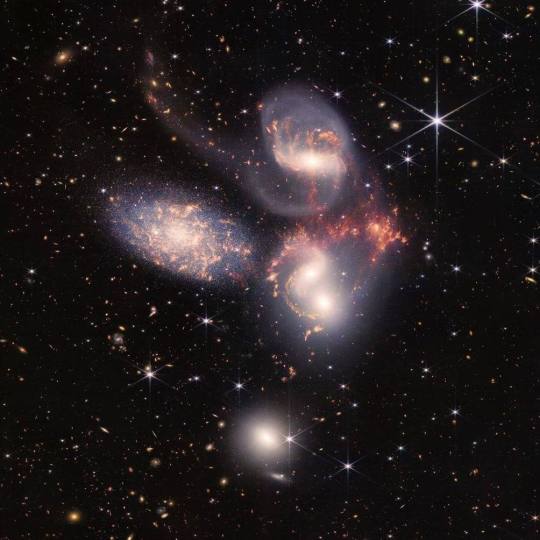
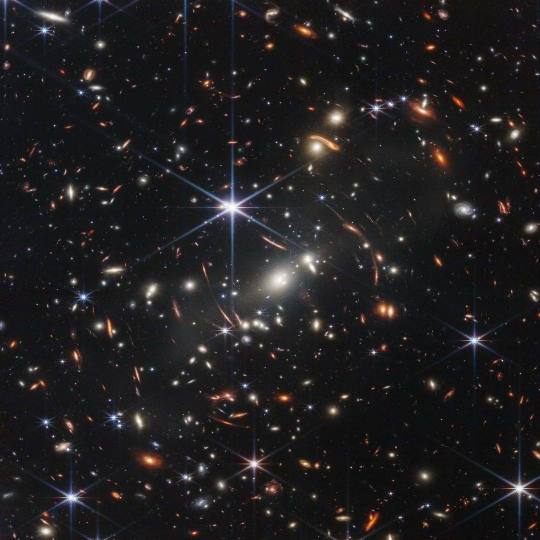
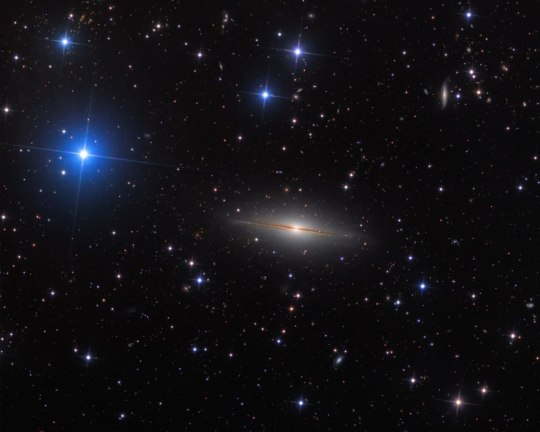
#fyppage#darkness#late night#night sky#darkcore#galaxy#outer space#planet#stars#dark space#dark hole#cosmic wonders#cosmos#space vibes#space aesthetic#james webb first full colour image#james webb telescope#james webb space telescope#james webb deepest sharpest view of universe#nasa#astrology#astronomy#astronaut#solar system#beyond the stars#james webb update#james webb images#space images#void#space art
270 notes
·
View notes
Text
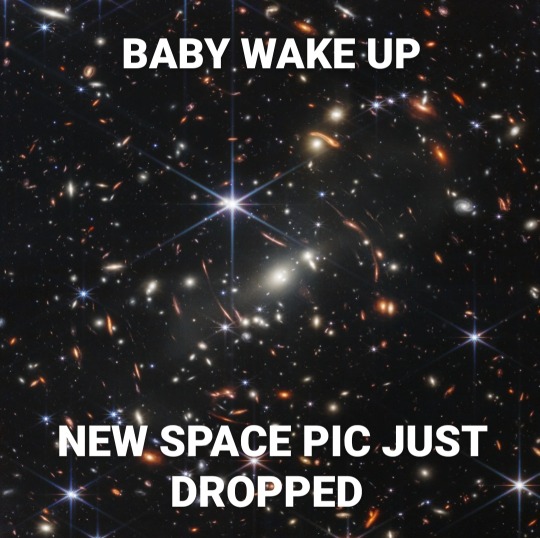
okay NASA release the alien pics now
392 notes
·
View notes
Text

27/07/2022
the James Webb telescope returned some pretty tigeriffic results...!
#tiger intern t#daily tiger#digital media#james webb images#james webb telescope#james webb space telescope#james webb first full colour image#james webb photos#space tiger#galaxy tiger#space art#huion kamvas
57 notes
·
View notes
Text
James Webb Space Telescope First Images
12th July 2022 marks one of the most important days in the history of mankind. James Webb Space Telescope revealed its first images and I am at a loss for words. This blog is more than a way to share information but is a thanks to all the scientists, engineers, ad everyone else on the Webb team and a way to congratulate the entire scientific community and human kind as this marks a major step in unravelling the universe. Now I know that mine is an aerospace page but this one is going to have an astrophysics and astronomy side to it. If you want to read about the engineering behind the JWST the do read-( https://www.tumblr.com/blog/view/aerospace-anant/672455873494384640?source=share)
SMACS 0723

NASA’s James Webb Space Telescope has delivered the deepest and sharpest infrared image of the distant universe so far. Webb’s First Deep Field is galaxy cluster SMACS 0723, and it is teeming with thousands of galaxies – including the faintest objects ever observed in the infrared. Webb’s image is approximately the size of a grain of sand held at arm’s length, a tiny sliver of the vast universe. The combined mass of this galaxy cluster acts as a gravitational lens, magnifying more distant galaxies, including some seen when the universe was less than a billion years old. Einstein’s general theory of relativity describes how mass concentrations distort the space around them.
A gravitational lens can occur when a huge amount of matter, like a cluster of galaxies, creates a gravitational field that distorts and magnifies the light from distant galaxies that are behind it but in the same line of sight. The effect is like looking through a giant magnifying glass. It allows researchers to study the details of early galaxies too far away to be seen with current technology and telescopes.
It is a composite made from images at different wavelengths, totalling 12.5 hours using the NIRcam – achieving depths at infrared wavelengths beyond the Hubble Space Telescope’s deepest fields, which took weeks.
This image shows the galaxy cluster SMACS 0723 as it appeared 4.6 billion years ago, with many more galaxies in front of and behind the cluster. We are looking back in time to within a billion years after the big bang when viewing the youngest galaxies in this field. The light was stretched by the expansion of the universe to infrared wavelengths that Webb was designed to observe. Other features include the prominent arcs in this field. The powerful gravitational field of a galaxy cluster can bend the light rays from more distant galaxies behind it, just as a magnifying glass bends and warps images.
2. WASP-96b
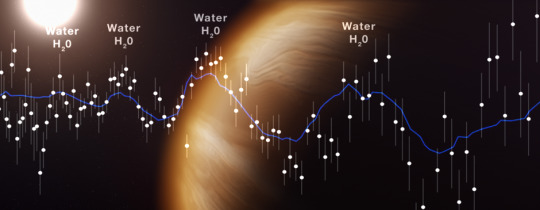
With a mass less than half that of Jupiter and a diameter 1.2 times greater, WASP-96 b is much puffier than any planet orbiting our Sun. And with a temperature greater than 1000°F, it is significantly hotter. WASP-96 b orbits extremely close to its Sun-like star, just one-ninth of the distance between Mercury and the Sun, completing one circuit every 3½ Earth-days. The combination of large size, short orbital period, puffy atmosphere, and lack of contaminating light from objects nearby in the sky makes WASP-96 b an ideal target for atmospheric observations. The observation, reveals the presence of specific gas molecules based on tiny decreases in the brightness of precise colours of light, is the most detailed of its kind to date, demonstrating Webb’s unprecedented ability to analyse atmospheres hundreds of light-years away. On June 21, Webb’s NIRISS measured light from the WASP-96 system for 6.4 hours as the planet moved across the star. The result is a light curve showing the overall dimming of starlight during the transit, and a transmission spectrum revealing the brightness change of individual wavelengths of infrared light between 0.6 and 2.8 microns.
While the light curve confirms properties of the planet that had already been determined from other observations – the existence, size, and orbit of the planet – the transmission spectrum reveals previously hidden details of the atmosphere: the unambiguous signature of water, indications of haze, and evidence of clouds that were thought not to exist based on prior observations.
3. STEPHENS QUINTET

Stephan’s Quintet, a visual grouping of five galaxies. This enormous mosaic is Webb’s largest image to date, covering about one-fifth of the Moon’s diameter. It contains over 150 million pixels and is constructed from almost 1,000 separate image files. With its powerful, infrared vision and extremely high spatial resolution, Webb shows never-before-seen details in this galaxy group. Sparkling clusters of millions of young stars and starburst regions of fresh star birth grace the image. Sweeping tails of gas, dust and stars are being pulled from several of the galaxies due to gravitational interactions. Most dramatically, Webb captures huge shock waves as one of the galaxies, NGC 7318B, smashes through the cluster. Tight groups like this may have been more common in the early universe when their superheated, infalling material may have fuelled very energetic black holes called quasars. Even today, the topmost galaxy in the group – NGC 7319 – harbours an active galactic universe, a supermassive black hole 24 million times the mass of the Sun. It is actively pulling in material and puts out light energy equivalent to 40 billion Suns. In NGC 7320, the leftmost and closest galaxy in the visual grouping, Webb was able to resolve individual stars and even the galaxy’s bright core. it will help scientists understand the rate at which supermassive black holes feed and grow. Webb also sees star-forming regions much more directly, and it is able to examine emission from the dust – a level of detail impossible to obtain until now.
4. SOUTHERN RING NEBULA
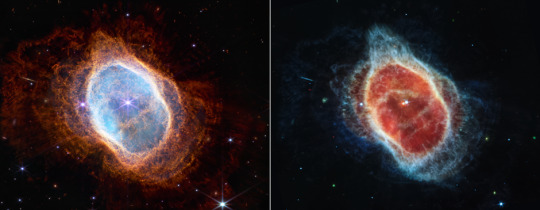
Two cameras aboard Webb captured the latest image of this planetary nebula, catalogued as NGC 3132, and known informally as the Southern Ring Nebula. It is approximately 2,500 light-years away. The dimmer star at the centre of this scene has been sending out rings of gas and dust for thousands of years in all directions, and NASA’s James Webb Space Telescope has revealed for the first time that this star is cloaked in dust. This observation shows the Southern Ring Nebula almost face-on, but if we could rotate it to view it edge-on, its three-dimensional shape would more clearly look like two bowls placed together at the bottom, opening away from one another with a large hole at the center.
Two stars, which are locked in a tight orbit, shape the local landscape. Webb's infrared images feature new details in this complex system. The stars – and their layers of light – are prominent in the image from Webb’s NIRCam on the left, while the image from Webb’s MIRI on the right shows for the first time that the second star is surrounded by dust. The brighter star is in an earlier stage of its stellar evolution and will probably eject its own planetary nebula in the future.
In the meantime, the brighter star influences the nebula’s appearance. As the pair continues to orbit one another, they “stir the pot” of gas and dust, causing asymmetrical patterns.
Each shell represents an episode where the fainter star lost some of its mass. The widest shells of gas toward the outer areas of the image were ejected earlier. Those closest to the star are the most recent. Tracing these ejections allows researchers to look into the history of the system.
As the star ejects shells of material, dust and molecules form within them – changing the landscape even as the star continues to expel material. This dust will eventually enrich the areas around it, expanding into what’s known as the interstellar medium. And since it’s very long-lived, the dust may end up traveling through space for billions of years and become incorporated into a new star or planet.
5. CARINA NEBULA

This landscape of “mountains” and “valleys” speckled with glittering stars is actually the edge of a nearby, young, star-forming region called NGC 3324 in the Carina Nebula. Captured in infrared light by NASA’s new James Webb Space Telescope, this image reveals for the first time previously invisible areas of star birth. Called the Cosmic Cliffs, Webb’s seemingly three-dimensional picture looks like craggy mountains on a moonlit evening. In reality, it is the edge of the giant, gaseous cavity within NGC 3324, and the tallest “peaks” in this image are about 7 light-years high. The cavernous area has been carved from the nebula by the intense ultraviolet radiation and stellar winds from extremely massive, hot, young stars located in the center of the bubble, above the area shown in this image.
The blistering, ultraviolet radiation from the young stars is sculpting the nebula’s wall by slowly eroding it away. Dramatic pillars tower above the glowing wall of gas, resisting this radiation. The “steam” that appears to rise from the celestial “mountains” is actually hot, ionized gas and hot dust streaming away from the nebula due to the relentless radiation. Because of Webb’s sensitivity to infrared light, it can peer through cosmic dust to see these objects. Protostellar jets, which emerge clearly in this image, shoot out from some of these young stars. The youngest sources appear as red dots in the dark, dusty region of the cloud. Objects in the earliest, rapid phases of star formation are difficult to capture, but Webb’s extreme sensitivity, spatial resolution, and imaging capability can chronicle these elusive events.
These observations of NGC 3324 will shed light on the process of star formation. Star birth propagates over time, triggered by the expansion of the eroding cavity. As the bright, ionized rim moves into the nebula, it slowly pushes into the gas and dust. If the rim encounters any unstable material, the increased pressure will trigger the material to collapse and form new stars.
BIBLIOGRAPHY:
1. https://www.nasa.gov/webbfirstimages
2. https://webbtelescope.org/contents/news-releases/2022/news-2022-031
3. https://webbtelescope.org/glossary.html#h3-CK-2572b869-1584-45c0-a18b-0c5ffcf32e57
4. https://esawebb.org/announcements/ann2207/
5. https://hubblesite.org/contents/articles/gravitational-lensing
#james webb first full colour image#physics#science#aerospace#space#tech#james webb space telescope#james webb 5 points on what new telescope aims to achieve james webb#james webb deepest sharpest view of universe#nasa#carina nebula#astronomy#webb#jwst#images#first images
13 notes
·
View notes
Text

made a new phone wallpaper for myself so I can look at it all the time🤩🤩🤩
#it’s just sooo fucking beautiful#reminds me of never ending story???#like I can’t even believe what’s out there#🥲🥹#space#jwst#james webb space telescope#aliens#galaxies#james webb first full colour image#nasa
6 notes
·
View notes
Text
James Webb: 5 Points On What New Telescope Aims To Achieve
James Webb: 5 Points On What New Telescope Aims To Achieve
The James Webb space telescope has a huge task at hand – to replace Hubble which has been serving as our eye in the sky for decades. The first image released by the new telescope on Monday did not disappoint. It showed the clearest image to date of the early universe, going back 13 billion years. American space agency NASA, which launched the telescope in space in December last year, has promised…

View On WordPress
#hubble#james webb 5 points on what new telescope aims to achieve james webb#james webb first full colour image#james webb space telescope#nasa
4 notes
·
View notes
Text
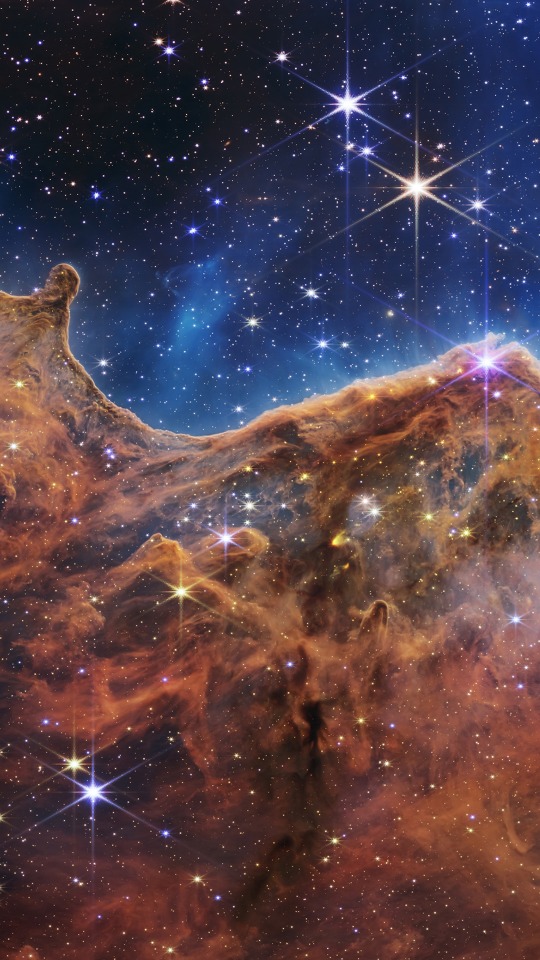
Fav phone wallpaper😍✨
4 notes
·
View notes
Text
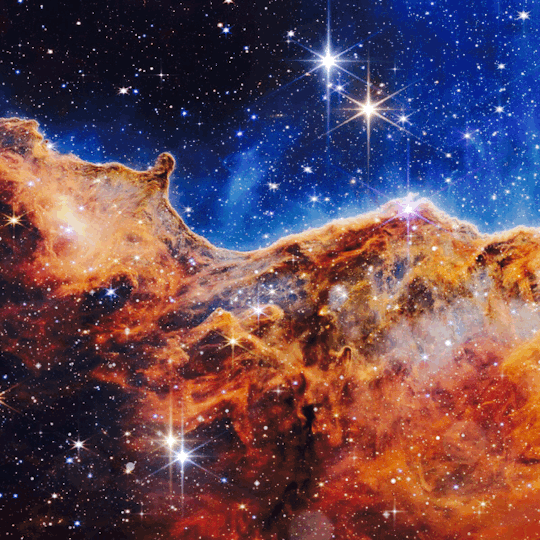

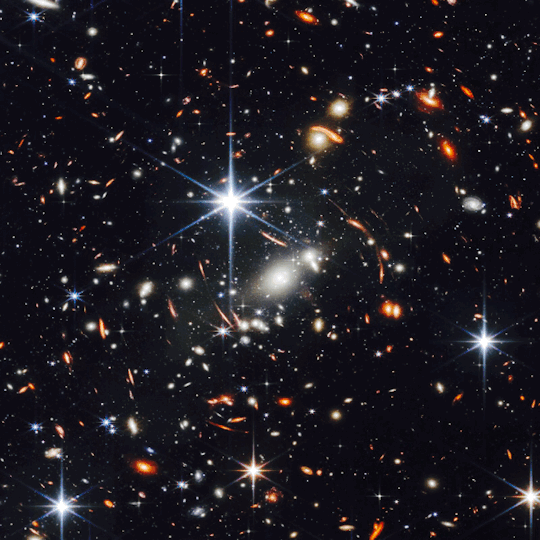

✨James Webb Beauty ✨
#gifs (edits) made by me :)#james webb telescope#james webb images#james webb update#james webb space telescope#james webb first full colour image#james webb deepest sharpest view of universe#james webb#nasa#space#space aesthetic#space vibes#galaxy#astronomy#astrology#stars#star#beyond the stars#void#to infinity and beyond#star cluster#nebula#infinity#outer space#webb#cosmos#universe#the universe#magic#glitter
11K notes
·
View notes
Text
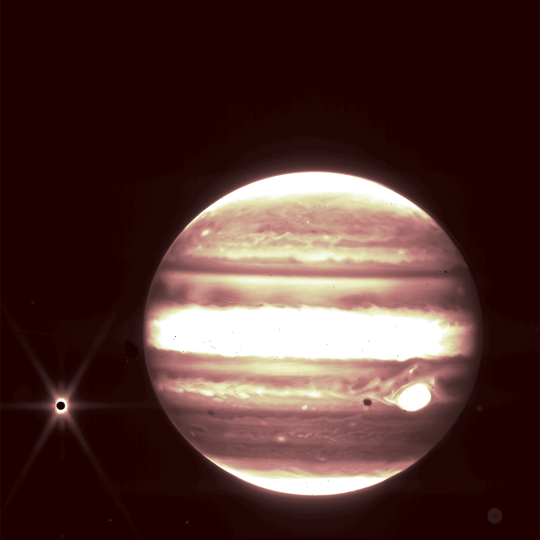
Jupiter, and its moon Europa, left, are seen through Webb’s NIRCam instrument 2.12 micron filter
James Webb telescope.
Image credits: @nasa
#space#spacex#galaxies#black holes#outer space#galaxy#jupiter#moon#james webb space telescope#jwst#nasa james webb telescope first image joe biden full color jwst space nasa#james webb images#james webb telescope#james webb first full colour image#planets#planet
258 notes
·
View notes